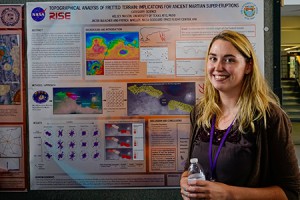Originally published October 4, 2016
By Kelsey Mason
Doctoral student, Geological Sciences
My 10-week internship was at the NASA Goddard Space Flight Center in Greenbelt, Maryland. I worked with Jacob Bleacher and his crew in the center’s Planetary Geodynamics Laboratory on a project titled “Characterizing the Explosive Volcanic History of Mars.”

Photo courtesy of Kelsey Mason
The origin of the fine-grained, sulfate-rich, friable deposits throughout the Arabia Terra (AT) region on Mars has been debated at length by planetary researchers. Evidence suggests these deposits are volcanic in origin; however, no viable sources (i.e. proximal explosive volcanoes) had been identified until recently when scientists discovered evidence for ancient super-eruptions in AT. These hugely explosive volcanoes, otherwise called calderas, are similar to that of the super-volcano Yellowstone. These volcanoes are the likely source for the enigmatic AT deposits, and therefore the source of this deposit warrants reexamination.
A key feature of the terrain in AT is its fretted texture, characterized by pervasive steep-sided mesas and flat valleys. The research I performed during my summer internship involved a quantitative analysis of the orientations of these valleys in relation to their depth and location throughout the fretted terrain using the Mars Orbiter Laser Altimeter (MOLA) Digital Elevation Model (DEM) (463 m/pixel). The results of my study suggest that the AT fretted terrain resembles a network of valleys formed by exploiting angular cooling and compaction fractures in a Late Noachian to Early Hesperian volcanic deposit.
I also attended several seminars at NASA, learning about cutting-edge research such as that pertaining to the New Horizons Mission which, after surveying the surface of Pluto, is currently on its way to the edge of our solar system, as well as research on the origins of the universe performed and presented by Nobel Laureate Dr. John Mather. I was privileged to view the James Webb Telescope scheduled to launch in October 2018, a mission that will provide the best imagery of the universe to date, and was working at NASA when the Juno Mission entered Jupiter’s orbit on July 4. I also met with many NASA scientists with similar research interests and gained knowledge regarding graduate school and my future career path.